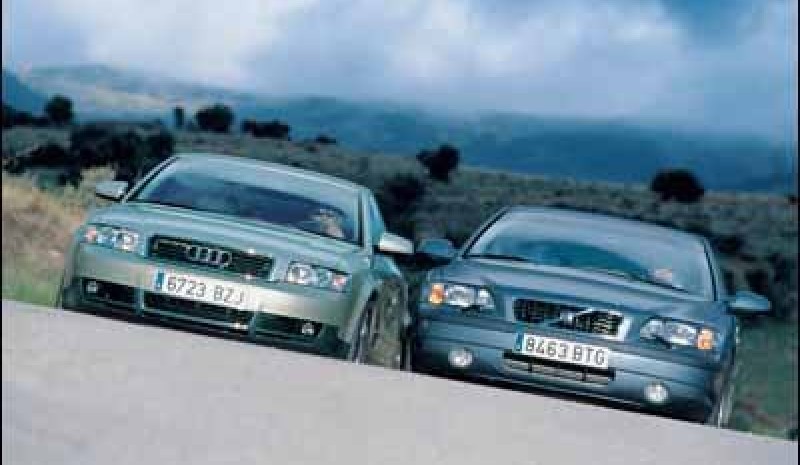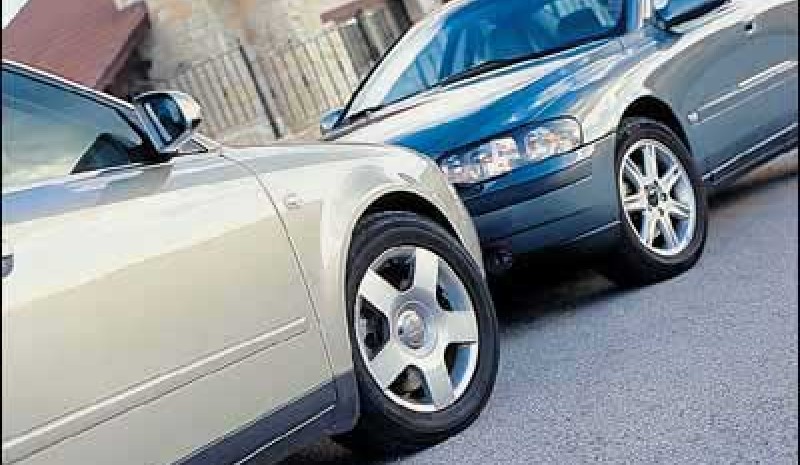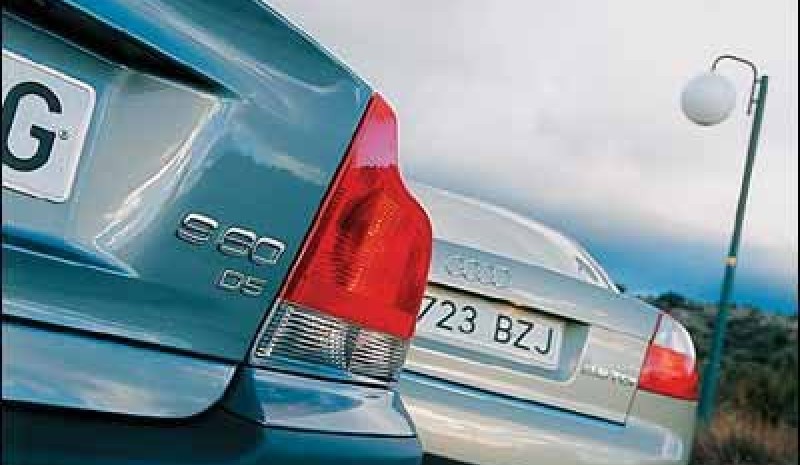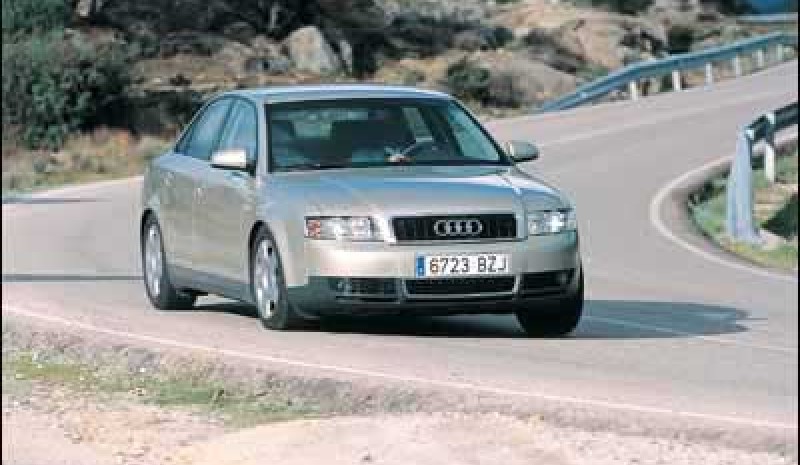Comparison: Audi A4 2.5 TDI 163 hp / Volvo S60 D5
Very approximate prices and the same power (163 hp), predicted what would later confirm: touch and comfort of these two models is so similar, costing significant differences. Practically decide on one or the other is a matter of taste rather than convenience or reasoning.


With the S80 first and the S60 later, Volvo has taken a giant step to be in the same league as Mercedes, BMW and Audi, becoming a valid alternative to the big German brands, dominating in the sector saloons prestige and luxury.
For its part, Audi, with the latest generation A4, has refined a product already very well managed and has a multi-valve V6 engine of modern architecture on top of availability Diesel. This engine has received from the Paris Motor Show this year, a slight touch on the central electronic control injection, yes, in charge of an already "demodé" rotary pump VP44, to look for something more low-end torque while power has increased from 155 to 163 hp. With this level of motorization, both Audi and Volvo are significantly more affordable than the 3 Series or Class C comparable and, together, have little difference in price: 33,190 euros costs 32,460 A4 and Volvo. This category hardly 730 euros can be considered significant and may have to study some details of optional equipment and to establish differences.
Both come with a full complement of airbags includes front, side and head both front and back, but the A4 includes stability control standard, requiring pay 1,202 euros extra if you intend to mount the same in the volvo. It seems a contradiction that a brand that bases much of his image on security has decided that the ESP is optional when another element such as cruise control is standard. At the end everything can be a matter of business strategy because from there, optional S60 are generally cheaper than the A4, which offers, in turn, a much more extensive list of options.
In both cars easy to find a proper driving position, accentuated this detail in the Audi for the possibility of having an electric lumbar adjustment double height. From there, the wide center console Volvo gives a feeling of greater "confinement", Especially in the lower body, but it is just that, a feeling that can be easy to forget to concentrate on driving.
Simple and elegant, while modern, Audi dashboard design is impeccable. Also fits the adjective beautifully finished dashboard for Volvo, with a design more control "the American" and a central more variegated console. Speaking of controls, disabling the alarm system Audi is located in a somewhat hidden inside lining of the driver’s door. It could be at hand with selections electrical memories of seats (when ordered this option).
Most Volvo length, 482 centimeters, 455 centimeters against the Audi, has been used to give more slack to the legs of the occupants of the rear seats (around six centimeters) and it is appreciated. Both models have a very comfortable shooting even with the Audi sport suspension moves somewhat less in the potholes. Both are slightly subviradores and have good traction. They also respond appropriately in tacking areas and if excesses are committed, stability controls are responsible for correcting trajectories, with a little more zeal in the Audi, but you can turn it off.
While readings favor the Volvo loudness, sound quality (especially at 3,000 rpm) is higher in the German car and this section should opt for it. Yet both are fairly quiet for its category.
Softness, progressiveness and undisguised energy are the greatest strengths of Volvo D5 engine, plus a very moderate consumption based on their performance. Against the Audi V6 engine, five Swedish cylinder does not seem so spirited but deceives. German propellant clearly surpasses the 0-100 km / h but, from there, in almost all figures is the Swedish engine which is imposed by asserting its system of common rail injection and variable geometry turbocharger. Anyway, the differences between them are more a matter of nuances. While the Audi V6 engine feels comfortable at high speeds, the Volvo seems lazier between 4,000 and 4,500 rpm, where the court is situated injection. The sixth gear Audi is clearly for fuel economy, but the rest of the gears are slightly shorter than the Volvo, logically arranging for more development. Despite the longest intermediate relations, the wide difference in torque for the engine D5 sufficient for the Volvo obtain figures superior passing performance and recovery, even rival that by a large difference takes chapter top speed, 227 km / h against 210 km / h.
Consumption is very similar in both with a slight advantage for the Swedish motor. In our test unit, the maximum torque value of A4 2.5 TDI has hardly changed although it is achieved at a lower rate and other presents differences in favor throughout the useful working band. This has also favored the regime of maximum power has gone from 4,250 rpm to 3,900 rpm but, in exchange, consumption have not changed.
As for braking distances, they are very good. The Audi get any meter in his favor in the 100-0 km / h, with faster response cycle in their pills that, in turn, lose a little mordant when its temperature rises, noticing some fatigue after several braking demanding.
In short, seldom we have we encountered such vehicles from different backgrounds so similar that transmit sensations. Although they differ in the character of its engines, the feeling of ride comfort, robust construction and controls resemble so much that the differentiating arguments to be found in shades or taste and personal circumstances.
With the S80 first and the S60 later, Volvo has taken a giant step to be in the same league as Mercedes, BMW and Audi, becoming a valid alternative to the big German brands, dominating in the sector saloons prestige and luxury.
For its part, Audi, with the latest generation A4, has refined a product already very well managed and has a multi-valve V6 engine of modern architecture on top of availability Diesel. This engine has received from the Paris Motor Show this year, a slight touch on the central electronic control injection, yes, in charge of an already "demodé" rotary pump VP44, to look for something more low-end torque while power has increased from 155 to 163 hp. With this level of motorization, both Audi and Volvo are significantly more affordable than the 3 Series or Class C comparable and, together, have little difference in price: 33,190 euros costs 32,460 A4 and Volvo. This category hardly 730 euros can be considered significant and may have to study some details of optional equipment and to establish differences.
Both come with a full complement of airbags includes front, side and head both front and back, but the A4 includes stability control standard, requiring pay 1,202 euros extra if you intend to mount the same in the volvo. It seems a contradiction that a brand that bases much of his image on security has decided that the ESP is optional when another element such as cruise control is standard. At the end everything can be a matter of business strategy because from there, optional S60 are generally cheaper than the A4, which offers, in turn, a much more extensive list of options.
In both cars easy to find a proper driving position, accentuated this detail in the Audi for the possibility of having an electric lumbar adjustment double height. From there, the wide center console Volvo gives a feeling of greater "confinement", Especially in the lower body, but it is just that, a feeling that can be easy to forget to concentrate on driving.
Simple and elegant, while modern, Audi dashboard design is impeccable. Also fits the adjective beautifully finished dashboard for Volvo, with a design more control "the American" and a central more variegated console. Speaking of controls, disabling the alarm system Audi is located in a somewhat hidden inside lining of the driver’s door. It could be at hand with selections electrical memories of seats (when ordered this option).
Most Volvo length, 482 centimeters, 455 centimeters against the Audi, has been used to give more slack to the legs of the occupants of the rear seats (around six centimeters) and it is appreciated. Both models have a very comfortable shooting even with the Audi sport suspension moves somewhat less in the potholes. Both are slightly subviradores and have good traction. They also respond appropriately in tacking areas and if excesses are committed, stability controls are responsible for correcting trajectories, with a little more zeal in the Audi, but you can turn it off.
While readings favor the Volvo loudness, sound quality (especially at 3,000 rpm) is higher in the German car and this section should opt for it. Yet both are fairly quiet for its category.
Softness, progressiveness and undisguised energy are the greatest strengths of Volvo D5 engine, plus a very moderate consumption based on their performance. Against the Audi V6 engine, five Swedish cylinder does not seem so spirited but deceives. German propellant clearly surpasses the 0-100 km / h but, from there, in almost all figures is the Swedish engine which is imposed by asserting its system of common rail injection and variable geometry turbocharger. Anyway, the differences between them are more a matter of nuances. While the Audi V6 engine feels comfortable at high speeds, the Volvo seems lazier between 4,000 and 4,500 rpm, where the court is situated injection. The sixth gear Audi is clearly for fuel economy, but the rest of the gears are slightly shorter than the Volvo, logically arranging for more development. Despite the longest intermediate relations, the wide difference in torque for the engine D5 sufficient for the Volvo obtain figures superior passing performance and recovery, even rival that by a large difference takes chapter top speed, 227 km / h against 210 km / h.
Consumption is very similar in both with a slight advantage for the Swedish motor. In our test unit, the maximum torque value of A4 2.5 TDI has hardly changed although it is achieved at a lower rate and other presents differences in favor throughout the useful working band. This has also favored the regime of maximum power has gone from 4,250 rpm to 3,900 rpm but, in exchange, consumption have not changed.
As for braking distances, they are very good. The Audi get any meter in his favor in the 100-0 km / h, with faster response cycle in their pills that, in turn, lose a little mordant when its temperature rises, noticing some fatigue after several braking demanding.
In short, seldom we have we encountered such vehicles from different backgrounds so similar that transmit sensations. Although they differ in the character of its engines, the feeling of ride comfort, robust construction and controls resemble so much that the differentiating arguments to be found in shades or taste and personal circumstances.


